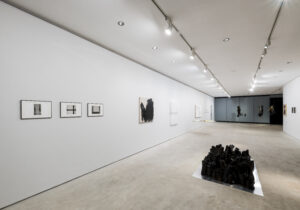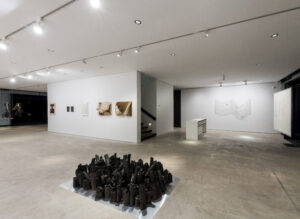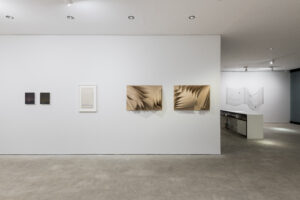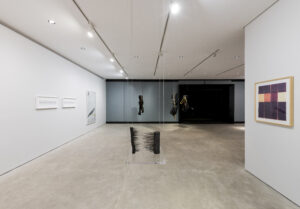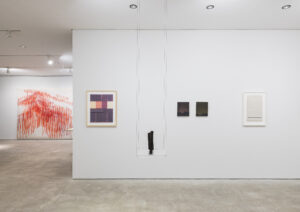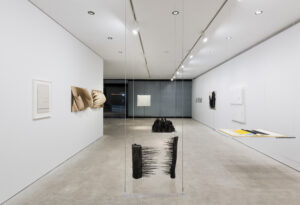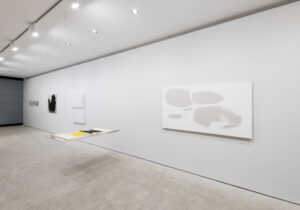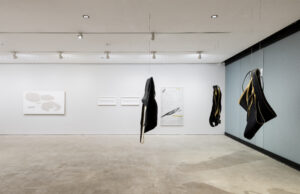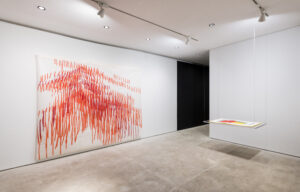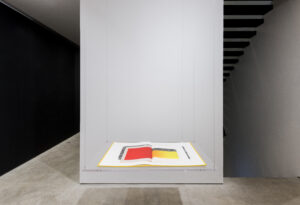in hands

between hands
ana roman e marina schiesari
This is a text in three movements. Each one seems, at first glance, autonomous. When united in this space, they form a choreography or a polyphonic communication in which each voice is unique but interdependent. The movements of the text focus on the hands – extremities of the upper limbs, articulated by wrist and extending to the fingers. In the first movement, the hands are serene, engaged in silent discovery and construction. In the second, they move intensely, reflecting conflicts and resolutions. In the third, they find balance and dance in harmony.
i- in hands
French philosopher and essayist Jules Michelet, in his book The Bird[1], delves into the behavior of birds. At a certain point in the essay, he asserts that the birds, lacking the hands of squirrels or the teeth of beavers, could be seen as workers without tools. However, their lightweight, rounded bodies become their instruments: with their chests, they press and compress materials until they become pliable, mixing and conforming them to overall work. In birds, their entire body is a hand.
The nest, their space of shelter and protection, mirrors, in a certain sense, the shape of their bodies: in the layering of twigs that serve as a place for resting, one could see fingers; the whole body of a bird is a tool for construction. And we, using our human hands, are capable of reproducing the shape of the nest by curling our fingers and cupping our palms upward. The gesture is one of welcoming both the material and immaterial world into our hands while creating containers, spaces of safekeeping and protection[2].
This exhibition, in many ways, extends its arms and curves its hands as we invite the young artists Ana Takenaka, iah bahia, and Nathalie Ventura to engage in dialogue with those already represented by Galeria Raquel Arnaud – Carla Chaim, Carlos Nunes and João Trevisan. The intertwining of these artists’ poetics is like the construction of a nest, where the twigs either thicken or soften, depending on the stage of construction: within the exhibition, there are moments when close relationships are woven, and others when there are merely hints of proximity or distance.
The artists gathered here, much like birds seeking to build their nests, employ their hands, bodies, and breath in an exploration of gestures.
II – coats and two-way roads
The relationship between hand movements and mental processes is complex. Setting aside the scientific debate to focus on philosophical and literary criticism, there is a certain tradition that links concrete actions performed by the hand, such as holding, taking, and grasping, to processes of thought, like remembering, dreaming, asking, and ultimately synthesizing. For Paul Valéry[3], for instance, the hand is an extraordinary organ in which resides all the transformative potential of humanity: it can counteract the course of things and modify them. When the hand works the material, its movements are precise and investigative, like those of a detective searching for something lost. There is a mental image to be extracted through meticulous movements that identify where to touch, where the material is sensitive, fragile, and malleable. Form emerges from these actions, giving the material a function or an aesthetic dimension.
The artists gathered in this exhibition teach various ways of grasping and constructing with their hands. In their gestures, we find a kind of alchemy: it is as if, through their hands, they can unveil secrets and bring new forms of being into the world. In the following paragraphs, we will dedicate ourselves to the exercise of identifying the layers (coats) that compose each artist’s poetics, aiming to highlight similarities and differences in how they appropriate materials and create their works. In doing so, we intend to trace a path of reciprocity, or build a two-way road.
Ana Takenaka and Carla Chaim draw. Interested in the movement of the hand (and the body) on paper, their artworks resonate with Degas’s assertion: “Drawing is not form, it is a way of seeing form”[4]. In prints and monotypes, Takenaka is preoccupied with representing sensations and thoughts through lines and gestures, exploring the potentialities of line and its abstract and representational fields. For Chaim, drawing expands beyond the boundaries of paper. In her works, her body leaves marks that reflect the tension between the imposed rules, such as a restricted color palette, and the organic movements that challenge them.
Carlos Nunes and iah bahia fold. “Dobrar” [the Portuguese word for “folding”] is a verb that inherently holds an interesting ambiguity: it means both to double or duplicate an object and to bend something so that one or more parts of it overlap. There is, in the poetics of both artists, a desire to simultaneously increase or decrease something in size. Nunes creates rules to explore relationships between various compositional elements. His work often culminates in (or starts from) a gradual exhaustion of material. In the exhibition, he presents an annual series of works made of tissue paper, which he folds and dyes with sunlight. In bahia’s works, connections are established between abstract points and lines, creating defined territories. In the Solitons series, for instance, she explores the shape of solitary atomic waves. By experimenting with forms through fabric, develops a topological methodology, revealing a dual space that challenges traditional notions of inside and outside.
Nathalie Ventura and João Trevisan dig. Similarly to the English “digging”, in Brazilian Portuguese “cavucar” is an informal expression that means to investigate, explore or dig into something with care or curiosity. By juxtaposing materials of distinct geological origin, Ventura unearths the fragility of lifestyles in the face of contemporary environmental and social challenges. Trevisan, on the other hand, explores the relationships between tension, weight and lightness. In his paintings and drawings, layers built up over time reveal depth and chromatic variation. Like Ventura, the artist constructs landscapes by excavating the material.
iii – marks on hands
Touch is a sensation present throughout the skin. Like Vergílio Ferreira writes: “In any part of the body we can mark the presence of an object, the presence of the real”[5]. One might ask if there are indeed different types of touch: the touch that perceives the things of the world and is distributed across the skin, and that which manifests primarily in the hands, reflecting and extending the activity of the self[6]. This latter type of touch also creates memory and, over time, a kind of library of what has been touched, understood, and recognized by touch. Invisible marks are produced on the surfaces of our hands.
In the current exhibition space, there are distinct surface repertories: from Japanese paper to craft, from charcoal to oil, from garment sewing to bookbinding. The warm materials (such as paper) and the cold ones (such as acrylic), as well as the gestures, perceived and explored by the hands of the artists access the sensory library of the viewer. Potentially, an encounter between sensitivities – the artists’ and the viewers’ – is created, along with possible connections between the self and the other: the desire felt in the body of those who see the works is to scratch, stretch, fold, dig… The hands become bridges between us and the world.
[1] MICHELET, Jules. The Bird. T. Nelson, 1874.
[2] For a discussion on the importance of the various ways of storing throughout history, see: LE GUIN, Ursula K. A Teoria da Bolsa de Ficção. N-1 Edições, 2021.
[3] VALÉRY, Paul. Eupalinos el Arquitecto y el Alma y la Danza. Antonio Machado Libros, 2019.
[4] Idem, Degas Dança Desenho. Editora Cosac Naify, 2003.
[5] FERREIRA, Vergílio. Invocação ao Meu Corpo. Bertrand, 1978, p. 273.
[6] Ibidem, p. 274.
exhibitions images
